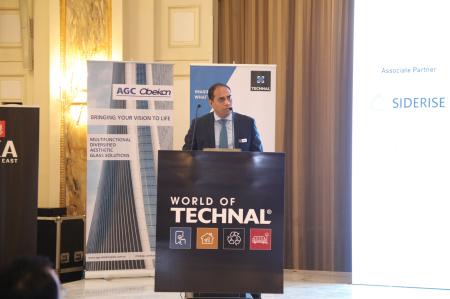Hydro Building Systems Middle East (the provider and producer of TECHNAL® systems) hosted a conference in Riyadh where industry leaders from the building and construction sector highlighted the need to lower carbon footprint in line with Saudi Vision 2030. Speakers from Zaha Hadid Architects, Kuraray Europe, Hydro Building Systems Asia, KEO International, Priedemann Facade Experts, AGC Obeikan Glass and Jotun Powder Coatings discussed that energy efficiency and conservation is essential for economic growth and how sustainable building designs and construction materials will boost the kingdom’s Vision 2030, which aims to generate 30% of the total energy required through renewable resources. The conference addressed the transition of cities into ‘sustainable cities’ of tomorrow.
Sam Robinson, managing director, Middle East and India, Hydro Building Systems Middle East, said: “We are pleased to open discussions about building solutions in compliance with Saudi Building Code that will help position Saudi Arabia as a leader in green buildings. With the mega trillion-dollar construction activities expected in the region in the coming years, sustainable construction practices and materials will be the driver for a safe carbon free future. Our goal is to construct sustainable building envelopes, in compressed urban spaces, where more people will live per square kilometer.”
One of the highlights of the conference was the launch of Hydro CIRCAL, which is a revolutionary aluminium alloy with more than 75% end of life recycled aluminium. Using Hydro CIRCAL aluminium alloy for building facades helps to reduce carbon footprint by 50% and this supports sustainability demands of Saudi Vision 2030.
Dr Werner Jager, director of Marketing and Technology, Hydro Building Systems, says: “Use of recycled aluminium for the windows, doors and curtain walls will reduce the carbon footprint of buildings. Today, the building skin just reduces the impact of the exterior climate on the interior climate conditions, by acting mainly as a separation layer. In the future, the building skin can, also, minimise the environmental impacts of the urban ambient areas, by active and passive design measures and products. Today’s building envelopes should also be designed to face threats such as fire, blast and ballistic attacks. Security for end users is of prime importance in today’s buildings. The building envelope of tomorrow will become a “connecting layer” providing a connection to the interior with exterior whenever possible and truly enriching the ‘user living experience’ in buildings.”
Fabian Hecker, Senior Associate, Zaha Hadid Architects talked about the importance of sustainability in architecture. Sandro Casaccio, Kuraray Europe GmbH, opened a discussion about climate change, harsh weather and improving safety. While AGC Obeikan Glass’s managing director, talked about immediate challenges facing the industry.
KEO International’s senior sustainability manager, Francis Porter highlighted latest technology developments in façade; Micha Pawelka, managing director, Priedemann Facade Experts, spoke about the challenges of implementing sustainable façade solutions; Nikolay Kolomiychenko, managing director, AGC Obeikan Glass highlighted the importance of ensuring energy efficiency; and Essam Aridi, country sales manager, Jotun Powder Coatings spoke about latest powder coating technology.
The conference was sponsored by Jotun, AGC Obeikan Glass, Siderise UK, Trosifol, and supported by AIA Middle East (American Institute of Architects) and RIBA Gulf (Royal Institute of British Architects), the leading representative association for global architects and designers in the Middle East.



